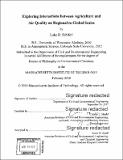| dc.contributor.advisor | Colette L. Heald. | en_US |
| dc.contributor.author | Schiferl, Luke D. (Luke Daniel) | en_US |
| dc.contributor.other | Massachusetts Institute of Technology. Department of Civil and Environmental Engineering. | en_US |
| dc.date.accessioned | 2018-05-23T16:35:12Z | |
| dc.date.available | 2018-05-23T16:35:12Z | |
| dc.date.copyright | 2018 | en_US |
| dc.date.issued | 2018 | en_US |
| dc.identifier.uri | http://hdl.handle.net/1721.1/115795 | |
| dc.description | Thesis: Ph. D. in Environmental Chemistry, Massachusetts Institute of Technology, Department of Civil and Environmental Engineering, 2018. | en_US |
| dc.description | Cataloged from PDF version of thesis. | en_US |
| dc.description | Includes bibliographical references (pages 123-135). | en_US |
| dc.description.abstract | As concern grows over increasing human population and the effects of industrialization on the environment, agriculture and air quality have become important areas of research. Both are vital to human prosperity, determining what we eat and what we breathe. The interactions between agriculture and air quality (defined by ozone and particulate matter (PM) concentrations) are many and often poorly understood. This thesis examines their interactions in two parts. First, we investigate the influence and characterize the importance of the variability in agricultural ammonia emissions on surface inorganic fine PM (PM₂.₅). In a case study, airborne observations indicate that summertime concentrations of ammonia throughout California and PM₂.₅ in Los Angeles are underestimated in a global chemistry model (GEOS-Chem) used to understand air quality issues. We find that increasing ammonia emissions from livestock and fertilizer allows the model to better represent the observations, thereby improving the model's prediction of PM₂.₅ conditions in wintertime, when concentrations and impacts on human health are greater. We also use new observations (surface, aircraft, and satellite) to find that the model underrepresents the summertime ammonia concentration near large source regions throughout the United States. Meteorology dominates the underestimated year-to-year variability in the model over reductions in acid-precursors. Introduction of varying ammonia emissions does not improve the model comparison and has little impact on PM₂.₅. Second, we quantify the impact of air quality on global crop production under current and future emissions scenarios. Using a relativistic approach, we find that the maximum positive impact (highly uncertain) from total PM light scattering can outweigh the negative impact from ozone damage in certain crops and regions. Future scenarios indicate that reductions in air pollution may have a net negative effect on crop production in areas dominated by the PM effect. We then employ a crop model (pDSSAT) to more realistically predict the lessened impact of PM under stress from resource restrictions. We also assess the effect of nitrogen deposition on crops compared to PM. Overall, we highlight the need for better observations of both ammonia concentrations and the impacts of PM on crop growth to reduce uncertainty in these interactions. | en_US |
| dc.description.statementofresponsibility | by Luke D. Schiferl. | en_US |
| dc.format.extent | 135 pages | en_US |
| dc.language.iso | eng | en_US |
| dc.publisher | Massachusetts Institute of Technology | en_US |
| dc.rights | MIT theses are protected by copyright. They may be viewed, downloaded, or printed from this source but further reproduction or distribution in any format is prohibited without written permission. | en_US |
| dc.rights.uri | http://dspace.mit.edu/handle/1721.1/7582 | en_US |
| dc.subject | Civil and Environmental Engineering. | en_US |
| dc.title | Exploring interactions between agriculture and air quality on regional to global scales | en_US |
| dc.type | Thesis | en_US |
| dc.description.degree | Ph. D. in Environmental Chemistry | en_US |
| dc.contributor.department | Massachusetts Institute of Technology. Department of Civil and Environmental Engineering | |
| dc.identifier.oclc | 1036988186 | en_US |
